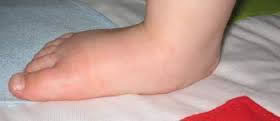Flat Feet (Pes Planus) in Children
What are flat feet?
A foot has a natural arch elevating the middle of the foot off the ground along the inside extending from the heel (calcaneum) to the balls of the feet (metatarsals). When this arch is reduced and the whole sole of the foot is on the ground then it is referred to as a flat foot.

Is it normal?
The majority of children under 5 have got slightly flattened arches but by the time they are 9 or 10 the feet have changed shape slightly and an arch forms on the instep.
A small minority of children have a persistently flat foot BUT THIS CAN BE ENTIRELY NORMAL FOR THEM. These children can participate in and play any sporting activity at any level. There is absolutely no reason to advise treatment for a child with a flat foot if they have no symptoms. Children who develop pain in their foot or wear out shoes rapidly can potentially be referred for treatment.
What can potentially lead to flat feet in children?
Usually no cause is found, it may run in families and it is just the way the foot is shaped. Some children have “over-pronated” feet and their ligaments can be generally lax.
In others, an abnormal fusing of bones in the back of the foot can cause the foot to be flat but also quite stiff under the ankle. This stiffness is called Tarsal Coalition. To tell if the foot is stiff you can simply stand on tip-toes and if the arch forms on the instep then it is probably not stiff. This is a relatively uncommon condition.
Some children with disorders affecting the nerves and muscles such as spina bifida, cerebral palsy or muscular dystrophy can have flat feet. Bear in mind the diseases are usually diagnosed well beforehand, and not just picked up because the foot is flat.
What are the symptoms?
Usually no problems are apparent. Children with over-pronated feet may wear out shoes quicker due to the weight distribution in the shoe. Pain along the inside of the foot or around the back of the foot can be indicative of a problematic flat foot.
How do you diagnose the condition?
Clinical examination can determine if the flat foot or over-pronated foot is flexible by examining the patient and watching the foot with the patient on tip-toes. The foot should be X-Rayed or even possibly have an MRI scan to look for a tarsal coalition (abnormal fusing of the bones in the back of the foot) if it is suspected.
How is it treated?
In the majority of cases no treatment is required. Patients and parents are often looking for reassurance. There is no evidence to support the theory that treating a childs “normal” flatfoot will prevent problems in later life.
If children are wearing out shoes rapidly and the foot is not stiff then insoles can be tried if the child is happy to wear them.
Patients with disorders such as cerebral palsy/spina bifida may need specially made braces or shoes to support their feet, but in children with these disorders, surgery to straighten the back of the foot may be required. This will be clearly explained and discussed with you with your orthopaedic surgeon.
When should you have surgery?
Surgery is not routinely advocated as first line treatment. If surgery is performed then it is often done as teenager, however schooling needs to be considered in the timing of surgery.
If the child is experiencing pain and there is a “tarsal coalition” or stiff flat foot, then surgery to separate the fused bones or straighten up the back of the foot may be required.
In patients with significant pain and a flat foot that is not stiff, surgery can potentially be performed to re-create the arch, and can be discussed with your surgeon.




